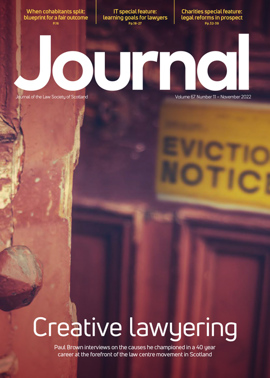Tenants’ rights: the scales tip further

On 27 October 2022, the Cost of Living (Tenant Protection) (Scotland) Act received Royal Assent. This latest residential tenancy reform operates to restrict rent increases and narrow the circumstances for securing eviction. There is also provision regarding private sector rent adjudication. The new scheme could have a profound effect in both private and social rented sectors in the coming months.
Passed as an emergency bill, like the Coronavirus (Scotland) Acts, this new measure also makes time-limited changes. The earlier emergency provisions making previously mandatory eviction grounds discretionary (i.e. subject to a reasonableness test) have been re-enacted in the general law, as explained at Journal, August 2022, 20. The latest Act continues the trend of fortifying the tenant’s position, though also incorporates some consideration for landlords.
Again, two possible time extensions are built into the scheme. The so-called rent freeze and evictions moratorium (the links are to briefings by the Scottish Parliamentary Information Centre, which adopts this terminology) are programmed to end on 31 March 2023, which failing 30 September 2023, which failing 31 March 2024 (although other dates are possible under regulations). The provisions relating to rent adjudication end on 31 March 2024.
Schedules effect the changes by amendments to the social renting regime in the Housing (Scotland) Act 2001 and the three extant private renting regimes, found in the Private Housing (Tenancies) (Scotland) Act 2016, the Housing (Scotland) Act 1988, and the Rent (Scotland) Act 1984 respectively.
At the time of writing, reports emerged about four representative bodies seeking a legal opinion on whether this measure might amount to a breach of landlords’ rights under article 1 of the First Protocol to the ECHR. No detailed consideration of this potential challenge will be made at this stage.
Background
The Act has retrospective effect from 6 September 2022, the date when the rent freeze and eviction moratorium were first aired in the Programme for Government. This means that, for example, rent increase paperwork properly served by landlords before 6 September can take effect, but papers served since then will be subject to the Act.
As explained below, there is no blanket freeze on rent or complete moratorium on evictions. Standalone eviction grounds have been created, which are in effect more rigorous existing grounds requiring a landlord to establish additional circumstances or a higher level of rent arrears than previously. Duties are placed on ministers to report on the law in action and consult with stakeholders at intervals in this law’s time-limited life, including further consideration of rent control in the social sector before 31 March 2023.
Schedules 1-3 are entitled “Rent Cap”, “Protection from Eviction”, and “Rent Adjudication” respectively. These will now be considered in turn.
Rent cap
Schedule 1 is the longest: not surprisingly, given the complexity of the measures and the need to replicate them over four separate renting regimes.
The private residential tenancy (“PRT”), the main player in the Scottish private rented sector, will be given particular attention here. There are also changes to the social sector, student residential tenancies, and assured tenancies, which will be covered for completeness.
Curiously, the first thing sched 1 caters for is more rent increases in a 12-month-period than would normally be permitted, but only if ministers allow this by regulations. Ordinarily, PRTs can be subject to one rent increase per year, on three months’ notice. This reform is a nod to pragmatism, and enables the Parliament to react to spiralling costs that might affect a landlord (discussed below).
Next, a new s 22A of the 2016 Act provides that from 6 September 2022 the landlord under a PRT may not increase the rent payable by more than the permitted rate. That rate is set at 0%, thus no rental increases are possible unless regulations substitute a different percentage. Ministers must review the permitted rate relatively soon in the social sector, but not in the private sector. Absent such regulations, any rent increase notice given on or after 6 September is of no effect – any landlord who speculatively gave such notice after reading the Programme for Government is caught by this section.
Subsequent amendments to the 2016 Act suitably constrain the rent variation provisions when the permitted rate is 0%, or modify them to (for example) stay a rent officer’s hand when it comes to ordering any increase when the permitted rate is more than 0%. Another curious effect is that the scheme removes the theoretical possibility of a rent officer reducing the rent after a landlord seeks an increase and a referral is made. Again this appears to be a pragmatic attempt at keeping the overall scheme fair to landlords.
The permitted rate of increase is not the full story. By a new s 33A, a landlord may apply to the relevant rent officer to increase the rent in a PRT by more than the permitted rate, in order to recover up to 50% of the increase in any “prescribed property costs” incurred during the relevant period. “Prescribed property cost” is relatively tightly defined, to include: (a) interest payable in respect of a mortgage [sic] or standard security relating to the let property; (b) an insurance premium (other than general building and contents insurance) relating to the let property; and (c) service charges paid by the landlord for which the tenant is responsible (in whole or part). “Relevant period” means the six months immediately before the day on which the application is made.
Assuming an application is all properly documented, the rent officer can approve an increase of no more than 50% of the hike in a landlord’s costs. This percentage can be increased or reduced by regulation.
Finally in relation to PRTs, the never used provisions on rent pressure zones (2016 Act, s 38) are suspended. These are not needed with this new scheme in play.
Analogous changes are made to the 1988 Act in relation to assured and short assured tenancies, also with up to 50% prescribed property cost increases allowed. No such changes were needed to the 1984 Act with its different rental regime.
In the social sector, where rent increases are comparatively less regulated, normally the only direct regulation of rent comes from s 25 of the 2001 Act. That only asks for proper consultation with tenants, and then four weeks’ notice before any increased rent comes into effect. Under the new Act with its permitted rate of 0%, no rent increase will be possible. There is no comparator for prescribed property costs. The concession offered to the social sector is the required prompt review of the provisions.
The last category catered for in sched 1, the student residential tenancy, normally escapes specific regulation, being carved out from the PRT provisions of the 2016 Act, but that carve-out now serves as the basis of a definition of this sector. As with the social sector, no rent increase is possible for leases to students while the permitted rate is 0%.
Protection from eviction
Schedule 2 restricts the effectiveness of decrees for removing from 6 September 2022, including decrees obtained but not yet actioned. It applies until either (a) the expiry of six months from the day on which decree was granted, or (b) the expiry or suspension of the restriction in accordance with part 2 of the Act.
There are some exceptions. First, student residential tenancies have their own eviction grounds. Students who engage in relevant criminal or antisocial behaviour in the regulated time period can be evicted.
Next, specific grounds from existing regimes may apply, notwithstanding what has loosely been termed a moratorium. For PRTs, these grounds include: the existing grounds of property to be sold by lender, tenant no longer being an employee, tenant not occupying let property, criminal behaviour, antisocial behaviour, and association with a person who has a relevant conviction or engaged in antisocial behaviour; and the new grounds of landlord intention to sell the property, or to live in the property, in order to alleviate financial hardship, and substantial rent arrears.
While these latter grounds are technically new, they can be fairly described as existing grounds on steroids. The existing grounds relating to a landlord’s plans for the property, already subject to a reasonableness test, are now made subject to a financial hardship criterion, properly evidenced. Evidence tending to support such grounds could include an affidavit from the landlord, or letter of advice from an approved money adviser, local authority debt advice service, independent financial adviser or chartered accountant.
Being in rent arrears for three or more months would normally be an eviction ground. The Act now asks for “substantial rent arrears”, defined as a situation where cumulative arrears equate to, or exceed, the equivalent of six months’ rent when notice to leave is given to the tenant.
In the other private sector regimes similar changes are made. The same is largely true in the social sector, although with a set figure for substantial rent arrears: £2,250.
Schedule 2 concludes with an amendment to the unlawful eviction regime in the 1988 Act. Currently the quantum of statutory damages is the difference between the value of the landlord’s interest with the “residential occupier” in occupation and the value with vacant possession at the time occupation ceased. Under the new formula, an award is to be made of between three and 36 months’ rent, the court or tribunal taking into account the manner of the unlawful eviction and the impact on the tenant, with relevant regulatory bodies and the police being informed of any award. The separate regime that can apply when a tenant, or tribunal, is misled into thinking that a PRT should be brought to an end when in fact the landlord was not entitled to recover possession, with its penalty of up to six months’ rent, has not been amended.
Rent adjudication
The final schedule provides for regulations relating to the determination of private sector rents under the 2016 and 1988 Acts, which may set out matters to be taken into account, matters to be disregarded, and assumptions to be made. They may also end the possibility of a tenant challenging a notice and then finding that the adjudicated rent is higher than the landlord asked for in the first place. That seems sensible, although it might also lead to landlords aiming high in a notice, knowing there is no chance of getting anything higher. Rent setters would need to be wise to this.
What next?
Landlord and tenant rights have been seesawing for many years. The prospect of additional weight being added to the tenant end of that seesaw has been clear since the last Scottish Parliament election. This new, temporary, Act continues that trend; more permanent legislation about rent control may yet be swapped into position. While there is a possible ECHR challenge based on peaceful enjoyment of possessions, the Act contains safeguards against challenge, such as the possibility of eviction proceedings with certain levels of arrears, the financial hardship grounds for recovery of possession, and some possible increases in rent. One thing is certain, though: for at least the next few months, this statute will weigh heavily in the residential tenancy sector.
Regulars
Perspectives
Features
Briefings
- Civil court: Broad sweep of the sheriff court
- Employment: Support through the cost of living crisis
- Family: Case management rules made for 2023
- Human rights: Protest as a defence to vandalism?
- Pensions: TPR issues auto-enrolment warning
- Property: New lease of life for commercial lets
- In-house: Advisers or leaders?







